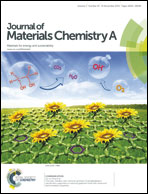Metal hydroxides as a conversion electrode for lithium-ion batteries: a case study with a Cu(OH)2 nanoflower array†
Abstract
Conversion electrodes, the materials of choice for the next generation lithium-ion battery (LIB), are mainly limited to metal oxides. In this work, we have investigated the electrochemical performance of chemically synthesized Cu(OH)2 nanoflower arrays. A 50 : 50 composite of Cu(OH)2 and multiwalled carbon nanotubes (MWCNTs) showed a reversible capacity of 522 mA h g−1 at a current density of 0.1 mA cm−2 with 95% retention of capacity after 50 cycles. The results demonstrate that it can be a competitive choice over the corresponding oxides as an anode for LIB.


 Please wait while we load your content...
Please wait while we load your content...